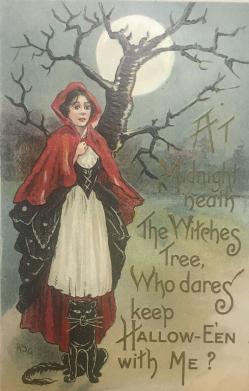Ancient Britons though
that Samhain, Lord of the Dead, imprisoned the souls
of wicked people in the bodies on animals and on the
night of 31 October he allowed these souls their
freedom for one night. During this night people were
at risk from malignant ghostly creatures of all
kind. To keep the spirits away villagers would burn
huge bonfires, wear costumes and sacrifice animals
to appease the spirits.
Little is recorded from this
period but Ancient Britons were known to live in
this part of Essex so it is very likely thousands of
years ago people lay in their huts after dark,
scared of demons roaming nearby.
As was the case in many pagan
events the Christian Church found it difficult to
break peoples old habits and simply replaced a pagan
celebration with a Christian one.
In the 6th Century the Roman
Catholic Church decided to introduce All Saints Day
on 1 November when Christians prayed for the souls
of dead saints.
These prayers were included
in a mass was called Alhallow Mass so the
night before became Alhallowmas Eve which was
shortened to Halloween.
Churches were encouraged to
ring their bells overnight on Halloween for all
human souls. Although a religious gesture This may
well have pleased the villagers as another step to
ward of Samhaim's creatures!
The effects of this overnight
ringing were felt by churches as the accounts of
Heybridge church show the charge of 8 pence by John
Gidbey for a new bell rope for use at Hallowmas and
later 1 shilling and 8 pence to Andrew Elliot for
repairing the third bell during use at Hallowmas.
Even after the introduction
of All Souls Day on 2 November to honor the souls of
all dead people, Sadly for the Church many
people still enjoyed celebrating the old pagan
festival as bonfires and dressing up in pagan
costumes offered excitement into dull lives that
simple prayer could not match.
Thus Eastern Essex would
still have seen people celebrating Halloween in the
old style by lighting bonfires, baking soul cakes
and of course drinking.
In the 16th Century the
Reformation reshaped the Church as a puritan element
dominated thinking. The church now opposed the
celebration of both the pagan Halloween and the
Catholic All Hallows day.
In 1604 the unsuccessful
attempt to blow up a protestant parliament and a
protestant king gave the church a great excuse to
establish a celebration on November 5th which
involved the normal pagan activities of a bonfire,
sacrifice of an effigy, dressing up and feasting.
This move proved very
successful and within a short period few people in
England celebrated the old Halloween although it was
still celebrated in Celtic areas of Scotland and
Ireland
We know that bonfires
celebrations were very popular in eastern Essex
although reports in newspapers from the mid 1800's
associate the bonfires with 5 November rather than
Halloween.

Halloween remained as
folklore with scary stories although there was
little personal celebration there are records of
late autumn events in this area using a Halloween
theme and traditions such as apple bobbing
began.
In the USA Halloween
celebrations were introduced by Irish immigrants and
without the clash with bonfire night grew into a
huge phenomenon with the adoption of Pumpkins, trick
and treat, costumes, parties etc.


